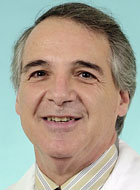The sound of a noisy Chicago restaurant during the breakfast rush — the clang of plates and silverware and the clamor of many voices — was the crucial test of new hearing-aid technology in a study conducted by School of Medicine researchers. The study showed that the hearing aids worked well in a noisy environment — the most challenging test for a hearing aid.
But the patients wearing the devices didn’t go to Chicago to participate in the test. Instead, the restaurant — or at least its sounds — came to the clinic of Michael Valente, Ph.D., director of the Division of Adult Audiology in the Department of Otolaryngology.

“We have a sound room set up to be an exact duplication of being in a loud restaurant,” said Valente, who has a joint appointment in the Program in Audiology and Communication Sciences (PACS), a division of the Central Institute for the Deaf at the School of Medicine. “It’s real restaurant noise, and it allows us to realistically test hearing aids. One of the most common complaints I hear from people who wear hearing aids is that they have stopped going to restaurants because they can’t communicate. So we are testing hearing-aid technology that might better help people hear in noisy places.”
The study, published in a recent issue of the International Journal of Audiology, was the first to use such a setting to test a new hearing aid technology — open-fit hearing aids with directional microphones. Open-fit means the devices let ambient sounds into the ear canal, unlike more conventional hearing aids, which completely block off the canal.
Directional microphones have long been available on conventional hearing aids, but researchers have questioned whether open-fit aids with directional microphones will be effective. Directional microphones help users distinguish conversation from background noise by partially canceling out low frequency sounds coming from the sides and from behind.
“We found that the open-fit hearing aids with directional microphones on average gave wearers a 20 percent improvement in speech intelligibility in the restaurant setting compared to not having a hearing aid or wearing an open-fit aid without a directional microphone,” Valente said. “We are the first to show that a directional microphone in open-fit can provide improved performance in noise.”
In fact, the aids without directional microphones performed worse in the noisy situation than no aid at all.
Open-fit hearing aids are designed for people who have normal hearing in the low frequency range but have lost hearing in the upper range, where most conversational sounds are. Valente said the open-fit hearing aids are what most new patients are asking for, but they are not the best choice for all hearing problems.
Next Valente will begin a project in collaboration with the National Association of Future Doctors of Audiology of PACS and with the Department of Ophthalmology in which they will measure sound and light levels in area restaurants. Often audiology and ophthalmology patients report they don’t enjoy restaurants as much as they used to because communication is difficult and they have a hard time reading the menu. So Valente and Mary K. Migneco, instructor in ophthalmology and visual sciences, and their colleagues will provide patients with a noise and illumination rating system that will help them determine whether they will find a restaurant comfortable.
The researchers soon will make this rating system available to the public via the restaurant review section of the St. Louis Post-Dispatch and its Web site as well as on the Web sites of the Division of Adult Audiology (audiology.wustl.edu) and the Department of Ophthalmology and Visual Sciences (ophthalmology.wustl.edu).